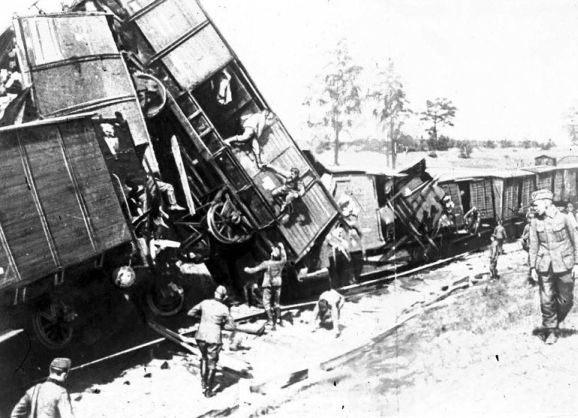Wrecking German supply trains was an important element in partisan warfare.
The outcome at Stalingrad had important effects on the population of German-occupied Soviet territory. The Wehrmacht’s inability to achieve the anticipated lightning victory, and the behaviour of German occupation forces, had already considerably cooled the enthusiasm with which many, particularly in the Baltic states, former Polish or Romanian territory and Ukraine, had initially greeted the invaders; support or at least acceptance of their presence was widespread as long as they appeared to be winning. However, the debacle at Stalingrad alerted the inhabitants of occupied areas, whether pro- or anti- Soviet, to the likelihood that ultimately Soviet rule would return, then those who had resisted the invaders would be rewarded, any who had not would be severely punished, and any who had actively assisted them could expect a rope or a bullet.
The consequence was a great increase during the first half of 1943 in the numbers joining partisan units behind the German lines – according to one account numbers doubled, so that by March there were up to 100,000 in 1,047 detachments, and by the opening of `Citadel’ the numbers had risen to 142,000. With so many men available, increasingly controlled and supplied by the regular Fronts, large-scale partisan operations became possible for the first time; on the night of 22/23 June, for example, the rail system in Bryansk province was attacked. It was claimed that 4,100 rails were blown up, but that is undoubtedly an exaggeration, as the same account described the main line along which German reinforcements and supplies came in as blocked only `for three whole days’. However, an indication of the extent of partisan activity is that these attacks took place only three weeks after the conclusion of a major anti-partisan operation, `Zigeunerbaron’ (`Gypsy Baron’), in precisely that area.
Partisan activity, small-scale and sporadic in 1941, had grown until guerrilla raids became too large and frequent to be countered solely by Einsatzkommandos, police battalions and (mostly Ukrainian) auxiliaries. It became necessary to use army units as well, and this diverted large numbers of German and allied troops from their front-line duties. Operation `Zigeunerbaron’ was a classic example. While preparations for `Citadel’ were in full swing, the entire 18th Panzer Division and other units, including Hungarian troops and Soviet `volunteers’, had to spend two weeks `purging’ the forest areas south of Bryansk of partisan forces estimated at 3,000-3,500 strong. The 18th Panzer Division alone claimed to have destroyed 207 `camps’ and 2,930 `combat positions’, killed or captured 700 partisans, killed 1,584 unspecified `others’, taken 1,568 prisoners and received 869 Red Army deserters, evacuated 15,812 civilians and burned down all villages in the area, thereby seemingly denuding it both of partisans and of all sources of support for them. Yet the partisans were able to mount substantial and coordinated attacks on the rail system only three weeks after `Zigeunerbaron’ ended.
#
German occupied territories
Of their prewar population of about 88 million, 15 million were evacuated before the Germans arrived; data put together in post-Soviet times indicate that 7.4 million of the 73 million who stayed were killed by the Germans and their collaborators or allies, some in accordance with General Plan `East’, which aimed to depopulate areas occupied by `inferior’ races to create room for German settlers, others as punishment for harbouring partisans. In addition it is estimated that 4.1 million died from hunger, infectious diseases or lack of medical care, and another 2.2 million while in forced labour in Germany. These add up to 13.7 million, more than half the estimated combined total of 26.6 military and civilian deaths, and 18.8 per cent of the population of the occupied areas; so almost one in every five Soviet citizens who came temporarily under German rule did not survive the war. Not surprisingly, those who could escape increasingly took to the forests to become partisans, or joined underground Party organisations.
